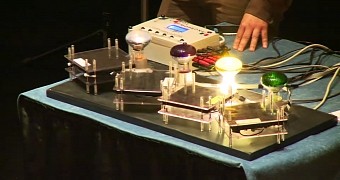During this year's Montreux Jazz Festival, a really unique instrument was brought by the physicists at CERN to have it played by the jazz pianist Al Blatter.
Called the "cosmic piano," this device works on data generated by cosmic rays to make beautiful music. Whenever a particle passes through a detector pad on the instrument, the result is a musical note and a flash of light. This way, the cosmic piano creates music. Not terrifically rhythmic or melodical, but if people put their mind to actually create some polyrhythmic music, some interesting music would come out.
The latest CERN piano is the invention of physicist Arturo Fernandez and his collaborator Guillermo Tejeda, who used components from the ALICE experiment to build it. The electronics were modified to convert the APD analog signals (two APDs inside each particle detector) into digital LVDS signals, produce music tones and light the LEDs when a detector catches a cosmic particle.
The Cosmic Piano has some features like producing light and sound only when n (n= 2, 3,...8) modules are hit at the same time or generate a “random musical noise” when any of the eight detectors is impacted by a charged particle.
The funny part is that the device has been so popular that it has managed to sell relatively well for how expensive it is, about $2,500. However, as far as music goes, you can hear how the artists desperately try to find some sense in the random sounds the device makes so they can create some actual music.

 14 DAY TRIAL //
14 DAY TRIAL // 